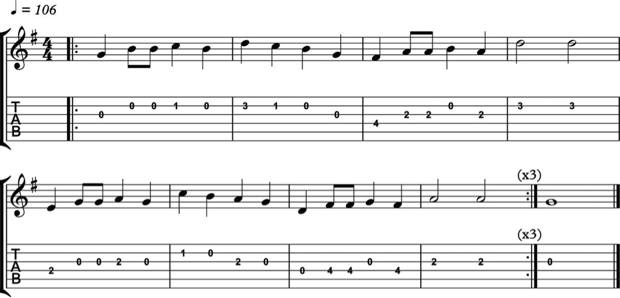In this article, Merv Young outlines the Accompaniment section of the RGT acoustic guitar exams.
One of the most important facets of acoustic guitar playing is the art of accompaniment.
Whether the guitarist is accompanying someone singing (either themselves or another vocalist) or accompanying another instrument, the ability to bring rhythm and harmony to a performance in a musically effective manner requires some practice.
The RGT Acoustic Guitar exams provide a structured way of developing this technique via the accompaniment section of the exam that occurs from Grade One onwards.
Having access to a variety of teaching resources is always important so, earlier this year, a series of three books with CDs were released under the title Acoustic Guitar Accompaniment.
Grade One
Book one in this series looks at the requirements for the Grade One Accompaniment section and explores a range of rhythm playing ideas that are attainable for this level of playing.
The chords that are used match those that are required for the Rhythm Study section at Grade One, so this becomes a useful supplement to your teaching of the acoustic guitar syllabus.
At this level, the main focus is on chord accuracy and fluency, so this becomes a useful resource for additional material that your pupils can practise with.
The book also includes plenty of ideas for some effective and manageable ways in which guitarists of Grade One standard can vary their rhythm playing to reflect some of the musical aspects of the melody they are accompanying.
Grade Two
In the second book in this series the focus moves to the requirements for the Grade Two exam and you’ll find a wealth of playing ideas and tips to help you teach your students at this level.
The examples presented in this Acoustic Guitar Accompaniment Grade Two book include fingerstyle playing, syncopated rhythms and ideas for accenting different parts of the rhythm pattern.
Whilst these techniques are not necessarily specified exam requirements for the Grade Two accompaniment section, they do provide a useful, structured way of developing your pupils’ playing and exposing them to some new approaches and techniques.
Grade Three
In addition to a large number of new chords at this grade, there is also the introduction of 3/4 signature. Several of the examples are presented in this new time signature, so this Acoustic Guitar Accompaniment Grade Three book becomes a very helpful resource in this respect.
The use of rhythmic variation and dynamics becomes a little more significant at this level, so there are plenty of tips and suggestions to develop these aspects of your pupils’ playing as well.
What’s In Each Book?
Each book contains 10 different melodies that have been notated, along with the appropriate chord chart for each one – so your pupils can practise and improve their accompaniment skills at a manageable and structured pace.
The examples below are taken from Book One.
There is a CD with each book that contains two versions of each melody.
The first version features the melody being played with an example chord accompaniment – to give you and your pupils a clear idea of what the guitar accompaniment ideas being presented should be sounding like.
The second version is the melody on its own for your pupils to practise their accompaniment skills over.
Of course, because each melody is notated in the book in both tablature and standard notation, you can always play the melody yourself whilst your pupil plays along.
By doing this you can vary the tempo to suit the pupil’s ability level whilst they are getting to grips with the ideas and techniques you are teaching them.
The chords that are required for each book and grade are included in a separate reference section with clearly presented chord boxes and fingering suggestions.
Remember that guitar accompaniment is not just about taking an exam; it is an essential playing skill and these books are a great resource for you and your pupils to use to develop this important aspect of their guitar playing.


